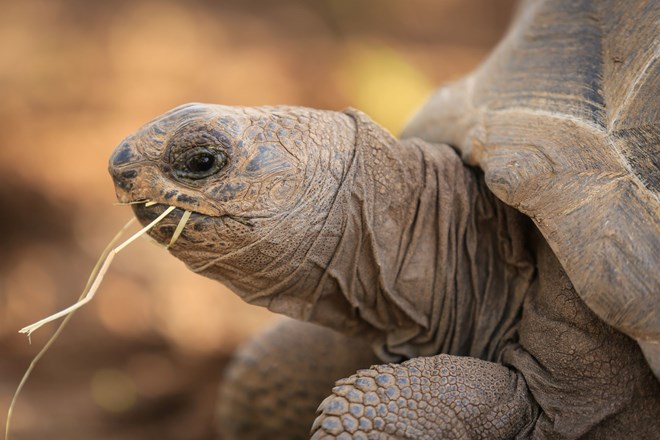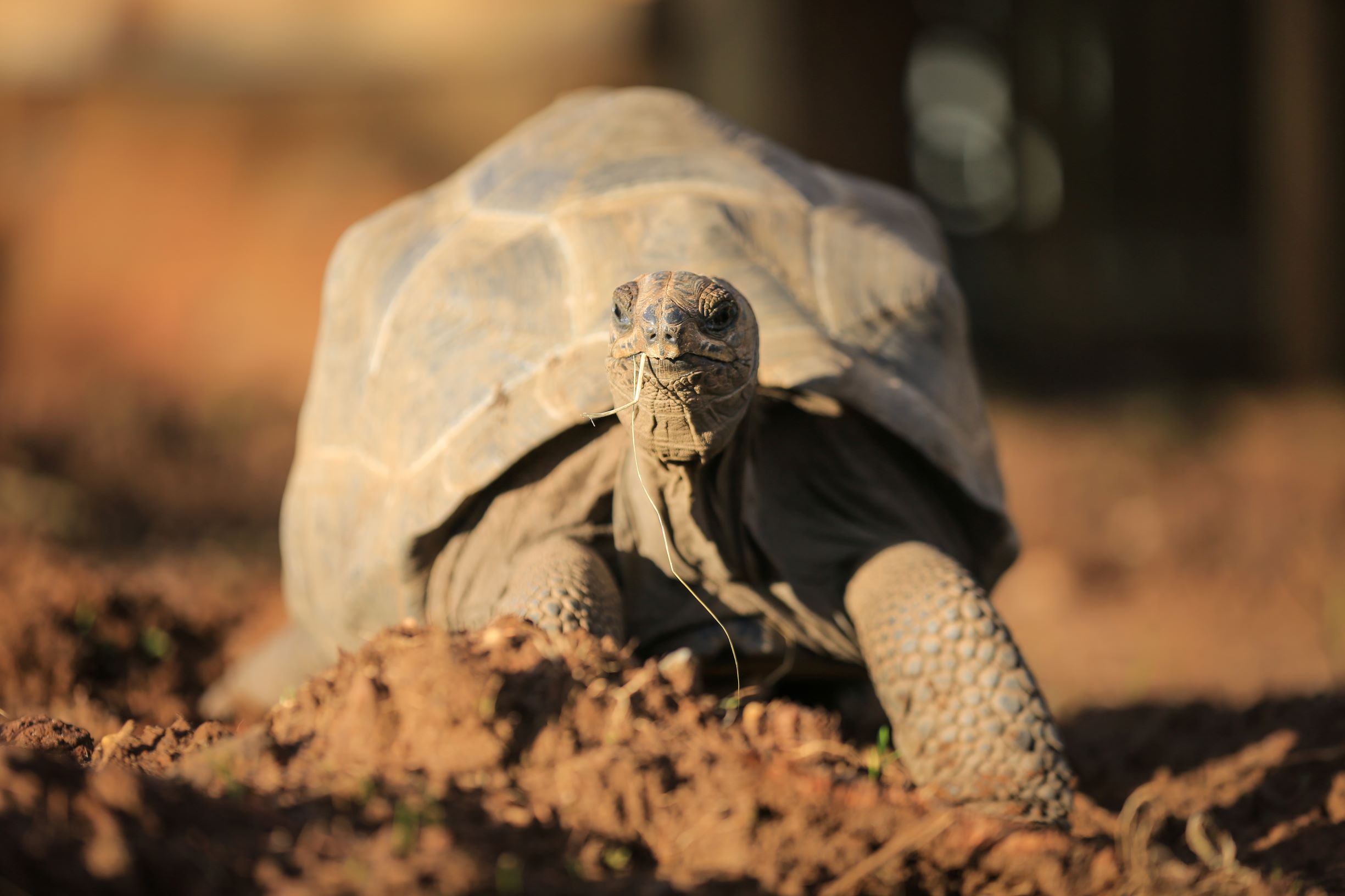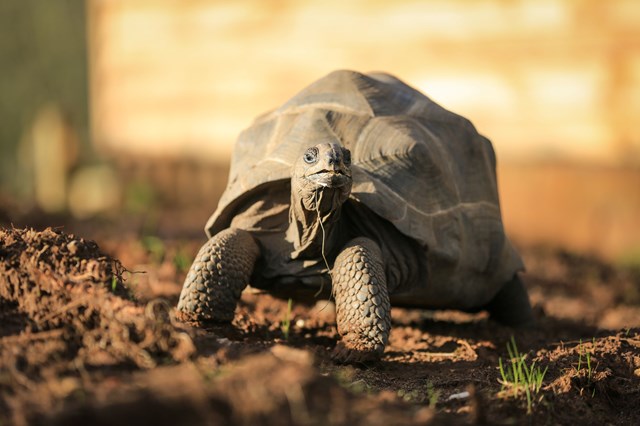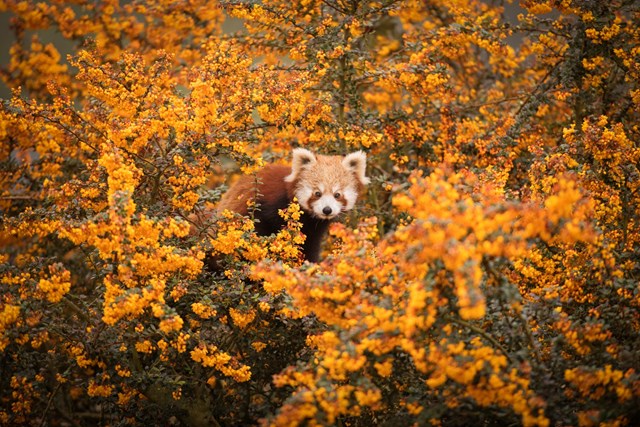
Overview
These slow-moving animals can be seen in the Foot Safari.
They have incredibly long necks, with thick, short, and round legs. They love to graze in the sunshine and use their powerful legs to make a mess and dig holes in their paddock.

All about us
| Distribution: | Aldabra atoll (Seychelles) in the Indian Ocean islands |
|---|---|
| Habitat: | Scrub areas, mangrove swamps and coastal dunes |
| Height: | Length Males 122cm, females 90cm |
| Weight: | Males 250kg, females 150kg |
| Lifespan: | Up to 150 years |
| Threats: | Predators such as rats and cats and competitors for food such as goats |
About us
Scientific name: Aldabrachelys gigantea
Aldabra giant tortoises are generally active in the mornings when temperatures are cooler; they are found both individually and in herds on open grasslands browsing for food. The aldabra giant tortoise is known to dig large depressions in swamps where they will rest and keep cool during the heat of the day.

The Aldabra giant tortoise has a dark grey domed shell which acts as protective armour. They have incredibly long necks which are used to tear leaves from the branches higher up. Majority of the time they are slow-moving animals with thick, short and round legs, almost flat feet that help them when they are walking on the sand. The robust limbs are covered in bony scales, as is the small, pointed head.
These giant tortoises’ feed primarily on vegetation and tend to be browsers. They wander over quite a wide area eating a wide range of seasonally available food. They are known to reach up on their hind legs to nibble on browse (leaves) which are slightly higher up. Aldabra giant tortoises gather in places known as ‘tortoise turf’, these areas are covered in a variety of grasses and herbs. They can be opportunistic reptiles with regards to diet, obtaining enough nourishment for survival; the tortoise may supplement its diet with small invertebrates and even carrion (dead animals).
In captivity Aldabra giant tortoises are fed on a variety of weeds and browse. In the winter months when vegetation is limited, they are fed on hay and kale (leafy cabbage). If a tortoise is fed on meat based products, fruits and root vegetables, it can have serious including shell deformities, poor bone density, metabolic bone disease and kidney damage.
Maturity is determined by size rather than age. Most tortoises begin to reproduce when they reach half their full-grown size, at around 25 years of age.
Mating is a noisy process, with the males bellowing like a bull, and chasing after the females. Copulation lasts for 10-15 minutes.
Female tortoises can lay 9 to 25 eggs between February and May, into a dry, shallow nest on the ground making them particularly vulnerable to being eaten by introduced predators. The temperature can affect hatching times and baby tortoises can emerge anything from 3.5 to 7 months later, normally coinciding with the arrival of the rainy season.
Young tortoises are vulnerable to attack by predators, such as birds and crabs, until their shells begin to harden and they reach a weight of about 15-20 pounds.
In the 17th to 19th centuries giant tortoises throughout the islands of the Indian Ocean had no significant predators or competition for food. Because of their immense size, they were only vulnerable when they were smaller and younger tortoises.
When people arrived on the islands and found both the tortoises and their eggs, they were captured, killed and stored for meat in the ship's hold. The Aldabra giant tortoise is a slow and cautious animal, yet they seem uninterested in the presence of people, indicating that one of the reasons that they were so easy for human settlers to hunt, was simply because these animals had no fear of them. Tortoise populations were hunted in mass, wiping out nearly all of them in less than 100 years. In addition, they have lost much of their natural habitat due to the destruction and expansion of human settlements throughout the atoll. The introduction of new predators such as rats and cats, and competitors for food such as goats further devastated the previously isolated populations. These wild tortoises are now threatened by climate change and rising sea levels - the Aldabra atoll is only a few metres above sea level.
Today, CITES lists the Aldabra giant tortoise in their Appendix II, meaning these animals are vulnerable in the wild. However, the Aldabra atoll has now been protected from human influence after having been declared a World Heritage Site. The captive breeding programmes on the islands of Mauritius and Rodrigues are reviving these species, and populations today are thriving.
Tortoises have been known to knock over small trees and shrubs to obtain nutritious leaves. This makes pathways and clearings within the forestlands for other animals.
It is believed that tortoises are the longest living of all animals. This is hard to prove because they have outlived the scientists that were studying them, and proper records were not kept.
One male specimen called "Adwaita" was reported to have been anywhere between 150 and 255 years of age when he died at Alipore Zoo in Calcutta, India.
The Aldabra giant tortoise has now had four scientific names to date, mainly due to the fact that there are on-going arguments about their similarity to other large Indian Ocean Tortoise species including the possibly extinct Seychelles Giant Tortoise.
Charles Darwin himself and other notable conservationists of the late 1800's along with the governor of Mauritius were involved with gaining this species protection in the Aldabra Atoll.

